It was July 2018 when I blogged the great news about an ERC Starter grant to develop a network theory of attitudes. And then I got busy, I guess, because I didn’t post here again until October 2021. We’re now about halfway through the grant, so I thought this would be a good time to write a bit about what we’ve done, and what we have left to do.
The first thing we did with the money was to start assembling an interdisciplinary team, with people trained in social psychology, mathematics, statistics, physics, and computational modelling. Our aim was to build a supportive and collegial team, and I think we’ve achieved that. Regardless of our successes and failures, we enjoy working together.
Our focus from the start was on evaluating the applicability of the proposed network models to the phenomenon (theory development), and experimentally confirming the proposed psychological mechanisms linking attitudes and social identity (basic human experiments). We’ve made good progress on both of these aims.
The core idea of the proposal is that people are linked by the attitudes they jointly hold, and that attitudes become socially connected when they are jointly held by people.
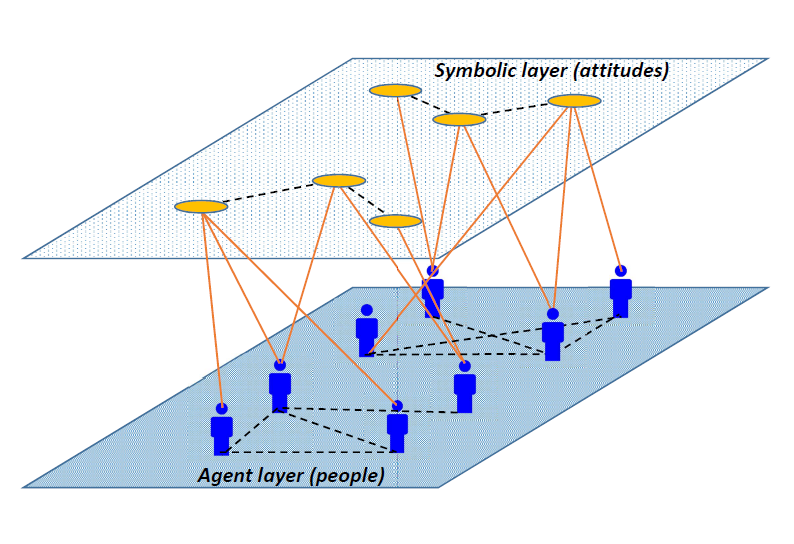
From this basic idea, we have developed methods to construct bipartite networks directly from survey-based data to visualize the relationships between people on the basis of shared attitudes. For example, this network is a visualization of vaccine-related attitudes in Bangladesh, from the Wellcome Global Monitor:
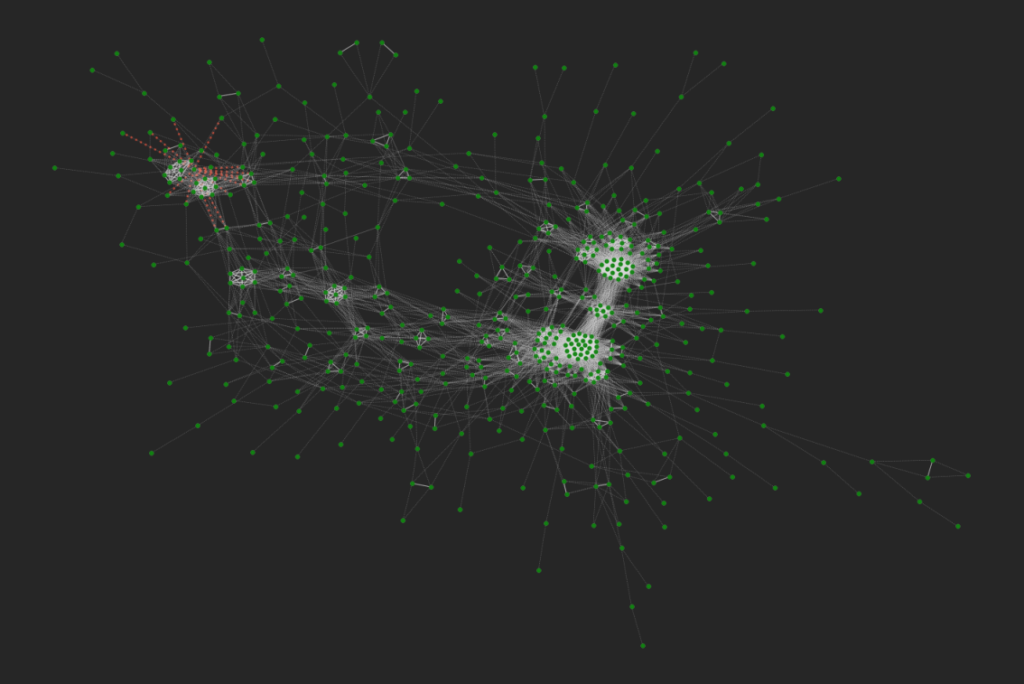
We can also view this social structure from the “other side,” and map connections between attitudes (on the basis of being jointly held by people). This produces a network-view of a set of opinions similar to those generated in belief-network analysis, but with fewer statistical assumptions. Here are the connections between attitudes in the same Bangladeshi vaccine network:
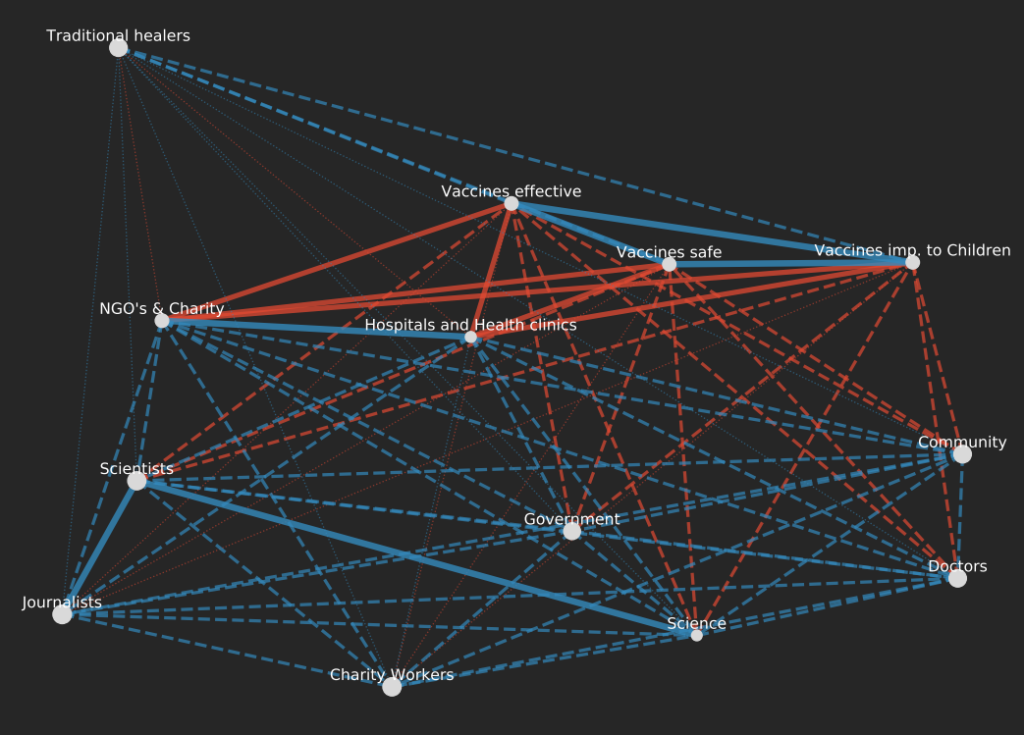
An important feature of the method is that we accept that these two views are inseperable features of the same social structure. You can read more about this method in our preprint. (And note that we have realized that we are walking in the footsteps of the sociologist Ronald Breiger who referred to this as “the duality of persons and groups.”)
We have applied this method to empirical attitude data collected in the first wave of the COVID pandemic in the UK. We were able to detect opinion-based groups, track their evolution over time, and show that membership of these dynamic opinion-based groups was associated with group-relevant health behaviours (doi:10.1111/bjso.12396). We think that the method is providing a unique, if incomplete, window on the relation between opinions, group identity, and behaviour.

We have done some work exploring the relationship of the method to other cluster-detection methods (e.g. hierarchical cluster analysis and stochastic block models), and found that we get broadly similar results but with the advantage of being able to locate individuals precisely in the structural opinion-space (see our preprint; currently in press at Advances in Complex Systems). The method also lends itself to detecting and quantifying opinion-based (i.e. ideological) polarization; and, as long as there is synchronization on opinions within groups, can even detect polarization without extremism (e.g. when two groups hold moderate opinions and yet never quite agree).
Perhaps most importantly, it gives us the ability to produce very cool visualisations :D!
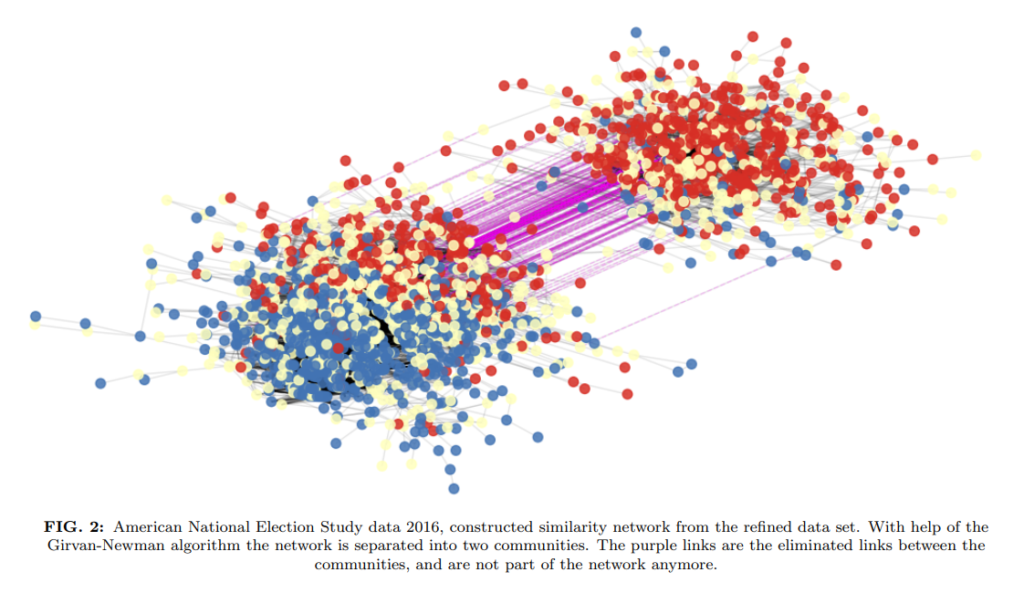
In our proposal, we said we would develop agent based models (ABM’s) implementing this type of social structure. With the help of experts who attended our project-launch workshop, we realized that Axelrod’s classic model of cultural diffusion natively relies on a bipartite network structure of people connected by attitudes. We extended this model, introducing a multidimensional equivalent of an agreement threshold, and found that the model generates plausible clusters similar to those observed in real data (doi:10.1371/journal.pone.0233995). We have shown that this model (where network edges represent similarity in opinions), is relatively impervious to underlying social network topology (e.g. friendship links) and we can therefore use this agent-based model to simulate opinion dynamics in realistic social systems even when we don’t know the social connections between people (doi:10.1016/j.physa.2021.126086). Our next step in this line of research is to see whether we can use the agent-based model to say anything useful about identity and opinion dynamics in real social systems (initially observed via surveys).
However, while the research above is very promising, it doesn’t tell us much about whether people actually perceive the world in this way, or whether the social structures we observe using these methods make any difference to how people socially identify or act in the world.
To examine these questions, we developed a new method that allows us to extract and illustrate belief networks among different groups in what we are calling an “attitude-space” (see our preprint). The graphic below shows a partisan attitude space of different political partisan groups in the US, based on participants’ item responses. To test whether attitudes can serve as marker of social identities, we correlated participants’ item responses with their self-reported political identification that the two evident attitude clusters map to Democrat´s and Republican´s attitude positions. In a second step, we exposed participants to other people´s attitude positions to see how the expression of attitudes by others relates to social perceptions. Our results showed that the extent of distance between one´s own attitude position in a network and the position of an attitude expressed by another person correlated reliably with how people socially categorize and emotionally perceive others (manuscript in preparation). We believe that this approach offers a novel view on the complex interplay between attitudes and polarization, both affective and ideological.
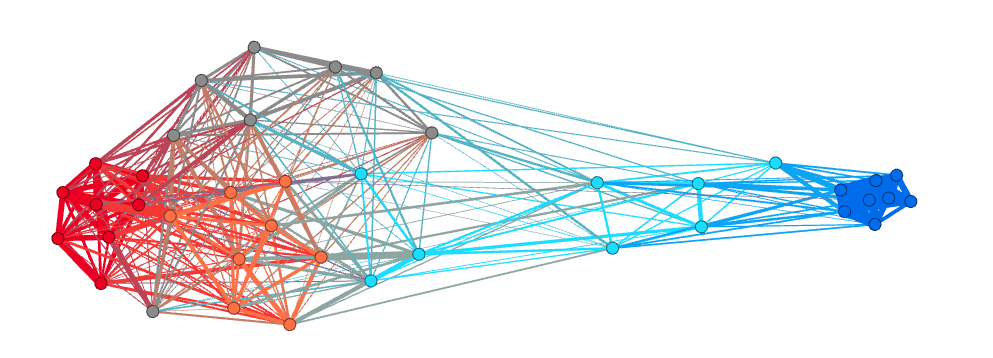

While correlational insights like these help us understand how attitudes translate into social identity phenomena, a main focus of our current work is on social experiments that test the causal hypotheses on attitude-identity dynamics offered by our model.
To test the psychological basis of opinion-based group identification, we wanted to develop a version of the minimal groups paradigm where people have the chance to agree and disagree with collaborators on novel statements that they’ve never heard before. This should allow us to test whether (a) joint agreement on attitudes promotes a sense of ingroup identification (over and above the identification from simply belonging to a minimal group) and (b) whether opinions that are incorporated into these minimal group identities are more strongly held as a consequence. To do so, we have developed a method for generating novel attitude statements — attitudes to which people have not yet been exposed and are unlikely to have a pre-existing opinion on (for example, “a circle is a noble shape”). We have piloted a selection of these, and now have a battery of novel opinions (or “Attitude sets”) to deploy in our experiments.
Despite Covid-related delays to our virtual interaction experiments (which previously relied on people participating together in a lab), we have run three experiments with human participants. These demonstrate that:
(1) Sharing novel opinions (and more specifically, expressing agreement on such opinions) results in people experiencing a sense of shared group identity.
(2) The sense of identification produced in opinion-based groups is stronger than that produced by the conditions in classical “minimal group” conditions where groups are differentiated on arbitrary dimensions (like preference for one painting over another).
(3) People come to have more certainty about attitudes that are associated with an emerging group identity.
We have also started to explore the role of attitudes in social media behaviour. We have identified a portfolio of real political bots, using available tools like the botometer, which we use to generate materials for experiments. In one of our ongoing projects, we expose participants to different bot and human accounts, and test whether attitude (dis)agreement between people´s own opinions and those held by an account profile can predict misperceptions of bot accounts as real users and vice versa. In other words, are people more willing to accept accounts as human if their posts are ideologically aligned with the participant’s own identity? Based on these emerging results we will design further studies to trial “micro interventions” that may help combat the spread of misinformation through online networks.

In the meantime, the VIAPPL software platform has been updated to allow a novel network game where participants exchange opinions and we will be piloting this in the next months. The platform offers the unique opportunity to study social identity effects in experimentally controlled social interactions settings, hence providing a maximum of internal validity. While the key focus of the VIAPPL research avenue will lie on the understanding of group formation through attitude alignment, it offers plenty of opportunities for other factors to explore. Manipulations of audiences (e.g. based on attitude homogeneity vs. divergence similar to social network sites), motivational states (e.g. zero-sum games, threats), or different attitude formats (e.g. “neutral” attitudes, socio-political attitudes) are just a few ideas to name for the beginning as possibilities are expanding through internal and external input from our team as well as from our network of collaborators.
So, are we halfway there? overall, our results exceed the expectations I had for the halfway mark when I wrote the proposal. There are some areas where we are lagging behind, but others where we’ve already gone well beyond what we could imagine at the start. We’re feeling excited about how these ideas can be applied and extended well beyond the scope of this grant.
We’re currently (October 2021) recruiting a new member of our team, and looking forward to seeing what this person brings to this programme of research! While we hope that people are excited by the work we’re doing, we are also aware that the complexity can be quite overwhelming to start with. Multidisciplinary work is very exciting, but we should be clear that no single person in the group understands every feature of the research we’re doing. The social psychologists lean heavily on the mathematicians/statisticians; and they rely on us for linking their models to social theory. In fact, that’s the thing I’ve enjoyed the most about the first half of this ERC grant – the great privilege of being able to work on ideas much bigger than I could have tackled alone.
[Attribution: Thanks to Adrian Lüders for additions to the section on the social experiments; and some great images from his current studies. All of the research reported here is a team effort! Please see references below for authorship. Disclaimer: some of the text is repeated in the ERC mid-term scientific report, which you will find on the European Commission Cordis website. For more information on the studies reported above, see the publication & impact page on the DAFINET website.]
References:
Carpentras, D., Lueders, A., & Quayle, M. (2021). A method for exploring attitude systems by combining belief network analysis and item response theory(Resin) [Preprint]. PsyArXiv. https://doi.org/10.31234/osf.io/uzdcg
Dinkelberg, A., MacCarron, P., Maher, P. J., & Quayle, M. (2021). Homophily dynamics outweigh network topology in an extended Axelrod’s Cultural Dissemination Model. Physica A: Statistical Mechanics and Its Applications, 578, 126086. https://doi.org/10.1016/j.physa.2021.126086
Dinkelberg, A., O’Sullivan, D., Quayle, M., & MacCarron, P. (2021). Detecting opinion-based groups and polarisation in survey-based attitude networks and estimating question relevance. ArXiv:2104.14427 [Physics]. http://arxiv.org/abs/2104.14427
MacCarron, P., Maher, P. J., Fennell, S., Burke, K., Gleeson, J. P., Durrheim, K., & Quayle, M. (2020). Agreement threshold on Axelrod’s model of cultural dissemination. PLOS ONE, 15(6), e0233995. https://doi.org/10.1371/journal.pone.0233995
MacCarron, P., Maher, P. J., & Quayle, M. (2020). Identifying opinion-based groups from survey data: A bipartite network approach. ArXiv:2012.11392 [Physics]. http://arxiv.org/abs/2012.11392
Maher, P. J., MacCarron, P., & Quayle, M. (2020). Mapping public health responses with attitude networks: The emergence of opinion‐based groups in the UK’s early COVID‐19 response phase. British Journal of Social Psychology, 59(3), 641–652. https://doi.org/10.1111/bjso.12396
